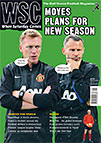 Both Cambridge clubs United and City have seen their requests for new grounds denied, writes Matthew Gooding
Both Cambridge clubs United and City have seen their requests for new grounds denied, writes Matthew Gooding
Earlier this year Cambridge City Council did a U-turn on plans to build a two-metre high statue of a Subbuteo referee on Parker’s Piece, a common near the city centre. An artist had been commissioned to design the work to commemorate Cambridge’s role in the formation of the laws of football; it is thought that the FA’s Laws of the Game were based on rules drawn up in the park in the 19th century by students from the city’s university.
However, negative public feedback and copyright issues meant the scheme, which would have cost £88,000, was abandoned before it had even begun, though alternative designs may be considered at some point in the future. Given that building even a statue in Cambridge is such a difficult business, it’s probably no surprise that both the city’s football clubs are having trouble finding sites to construct new stadiums.
A series of catastrophic financial decisions led to Conference team Cambridge United selling their current Abbey Stadium home to former director John Howard in 2005. He in turn sold it on to Grosvenor Estates, who are now trying to relocate the U’s to a new stadium on green belt land at Trumpington, south of the city. This would leave Grosvenor free to build houses on the Abbey site, for which United have a 40-year lease, as well as giving the perpetually hard-up U’s a modern stadium in which to grow their
non-footballing income.
The 8,000-capacity community stadium would be part of a larger “sporting village” complex, with full-size hockey and rugby pitches, an indoor sports hall and a base for United’s Youth and Community Trust, which currently works with 2,500 children in the region and is looking to grow this number to 10,000. However, in May councillors ruled out removing the land from the green belt to allow the stadium to be built, as well as rejecting eight alternative sites proposed by Grosvenor.
The reason given was that the need for a community stadium had not been proven. This came as a surprise to both the club and Grosvenor, who say they had been liaising with planning officers about the stadium for two years and this issue hadn’t come up before. United chairman Dave Doggett said: “Reports done in 2008 identified a clear need for sport facilities in the county and after all the post-Olympic legacy talk about encouraging more people into sport, it’s astonishing that a previous report has been dismissed because a number of people have objected to the proposal.” The feeling among fans is that the council decision was made to appease a relatively small but vocal number of Trumpington residents, who are opposed to any further development in the area, particularly one which would see football fans descending on what is one of the city’s most affluent suburbs.
Cambridge City, currently in the Southern Premier League, left Milton Road, their home of more than 90 years, in April and next season will be ground-sharing at nearby Histon. The Lilywhites are looking to build a new ground at Sawston, also on Cambridge’s southern fringe, but their proposals were rejected by South Cambridgeshire district councillors, who cited the loss of green belt land as well as the potential increase in traffic. The same meeting saw a scheme for 540 new houses on the same road in Sawston given the green light; presumably councillors believe these will cause less traffic than City’s 250 supporters turning up once every couple of weeks for league matches.
Both stadiums would provide new sports pitches for local people and community clubs to use. These are in high demand in a city where the best facilities are controlled by the all-powerful university, who never seem to have any trouble obtaining planning permission for their latest ventures.
Sadly the local authorities don’t seem interested in helping either club thrive and grow in the long term, or in fulfilling the much-discussed London 2012 Olympic legacy and providing more opportunities for people to take part in sport.
United and City have pledged to press ahead with their respective plans, though neither seem keen on the logical step of pooling their resources and trying to get permission for one shared stadium. Perhaps if a new ground is ever built they’ll find a space outside to erect the Subbuteo statue.
From WSC 319 September 2013